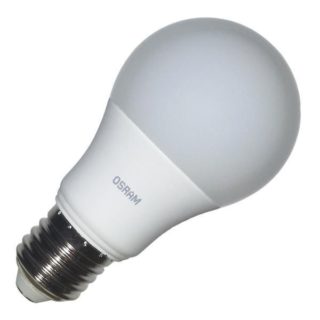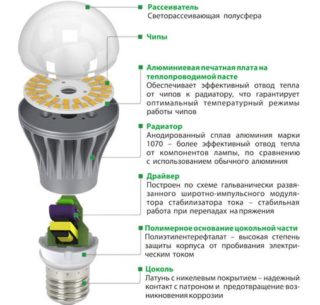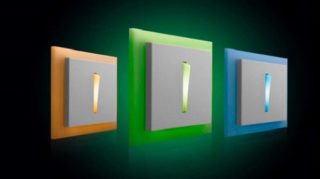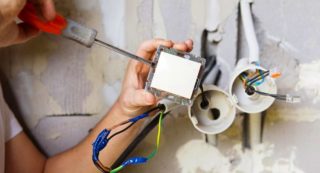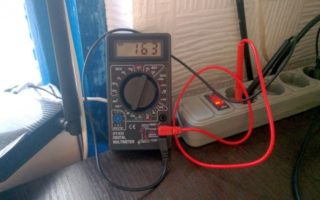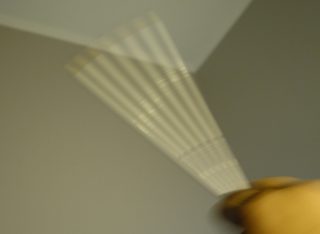LED lamps are the most modern light sources. They are economical, reliable, efficient and work long. LEDs are safe for human vision and the nervous system, as they do not have ripple when properly designed and connected. If there is a violation, flicker may be observed, which must be corrected.
The principle of operation and device
LED lamps have a more complex structure compared to incandescent or halogen lamps. The design includes the following details:
- Hemispherical diffuser. It is made of plastic or glass.
- LED matrix.
- Aluminum board for heat dissipation.
- Radiator.
- Driver. It is because of a poor-quality driver that the most often blinks a light bulb.
- Basement base made of polymer.
- Basement
Depending on the type of light bulb, the design may vary.
In classical light sources, voltage was applied directly to the spiral, which played the role of active resistance. LED contains special converters - drivers. When power is applied, current flows through the base to the converter, and then to the LED matrix itself. The converter changes the current and voltage to the optimal values for functioning.
The following main causes of flickering lamps can be distinguished:
- Constant surges in electricity.
- Low mains voltages.
- Malfunction of components in the circuit.
Breakage needs to be found and eliminated as soon as possible.
Causes of flickering cheap lamps
Cheap products from little-known manufacturers often do not meet the declared characteristics. Lowering the cost of goods is associated with the use of low-quality materials and savings on electronic components. This can be seen in cheap LED bulbs, which begin to flash almost immediately after purchase. The manufacturer installs cheap drivers, does not use radiators, and this affects the operation of the device.
The blinking of the lamp is common, but in most cases the device remains operational. If the cause of the blinking is eliminated, the bulb can be used for the time declared by the manufacturer without harm to health.
In cheap appliances, troubleshooting is not always possible. For this reason, it is recommended that you immediately buy a trusted device from a reliable supplier. At the purchase stage, it will cost more, but all the declared characteristics will correspond to the operating parameters.
Lamp flickering due to poor power supply
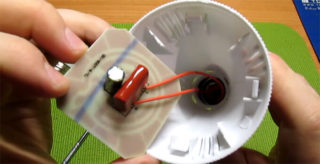
Not only cheap bulbs are subject to pulsations. Devices from the middle price segment can also contain a cheaper power source in their design, which will cause flickering at startup.
The power supply consists of the following elements:
- Diode bridge with capacitive filter.
- Extinguishing capacitor.
An alternating current is supplied, which passes through the diode bridge. When passing, it is converted to direct current of the required size, but with high ripple. Capacitive filter and blanking capacitor reduce flicker. Current with equalized characteristics falls on the lighting device, so that the lamp is operating normally.In the case of using low-quality components, the circuit will not be able to achieve the desired characteristics, because of which flicker will be observed.
Blinking can be detected both on one lamp and on the whole group. The causes of this phenomenon are the same, and they need to be addressed so that the working life of the devices is not reduced. A malfunction may occur in the off and on state.
Blinking when off
Ripples in the inactive state of the circuit breaker can be detected due to electric current entering the smoothing capacitor. It accumulates current, which, when filled, falls on the circuit and tries to activate the LED lamp. This stock is not enough for full functioning, so the lamp will light up for a short period of time. The flashing will be repeated until the problem is resolved or the lamp breaks.
The following components can affect the flashing of lamps:
- switch backlight;
- induced voltage;
- leakage currents.
These reasons need to be known in order to be able to quickly eliminate them.
Switch backlight effect
Many manufacturers equip their switches with backlight. It increases the comfort of use, as the switch starts to burn and it becomes easier to find in the dark.
But additional illumination can cause flicker, especially on cheap bulbs. This is due to parallel connection. In the off state, the current goes to power the backlight, and when turned on, to the lamp.
This reason is one of the most common, therefore it is on the backlight of the switch that you need to pay attention to when the lamp is flickering.
Induced voltage
Occurs when several devices are connected to one multicore cable. It can also be observed when laying several independent lines in one strobe.
You can fix the problem by replacing one LED light bulb with a device of lower power. For a while you can put an incandescent lamp, but you need to remember that it will also be affected by the induced voltage. The best solution would be to change the wiring section and highlight a separate line for the lighting group.
Leakage currents
Leakage current is the most dangerous reason a light flashes. It appears due to poor-quality and improper installation, insulation damage, poor contact. As a result, an open circuit appears that can cause a fire. Even when inoperative, currents will flow to electrical appliances.
Remedies
If the lamps blink due to the backlight on the switch, an open circuit must be performed. There are 6 main troubleshooting methods:
- shunt resistor;
- capacitor bypass;
- connecting the backlight with a separate wire;
- use of a passage switch;
- dismantling the backlight inside the switch;
- inclusion in parallel of an ordinary LED light bulb.
Turning off the backlight of the switch is the easiest way. First, the switch is dismantled, and the wires for the backlight are turned off. You can also replace the old switch with a new one. It is recommended to take the device with a neon backlight - it flickers less often than LED.
When blinking groups of light sources, you can put instead of them one incandescent lamp with low power. Flickering should disappear, but keep in mind that the aesthetic properties of the chandelier will be violated.
Fixing the problem is the installation of a low-power resistor at 50 kOhm for a power of 2 watts. Work must be carried out efficiently, otherwise there is a risk of fire. All contacts must be securely insulated.
Blinking may occur due to insulation problems.Violation of its integrity leads not only to the unstable operation of the lamp, but also to a danger to human health.
Leakage currents can only be repaired by repairing problematic sections of the circuit. Sometimes it may be necessary to replace all the wiring in the apartment or house.
The lamp blinks when the switch is on
If the switch is in the active state, two causes of flashing can be distinguished:
- Weak voltage. Any light source is sensitive to low voltage. If a high-quality driver is installed in the LED bulb, stable operation can be achieved even at 180 V. Lamps without a high-quality driver turn off already at 200 V. Flicker at a voltage below 220 V will be observed at different frequencies and will stop when normal operating values are reached.
- Poor power supply. If the voltage is normal, the problem may be due to the power supply. Using low-quality elements will not allow the device to equalize the current and bring the values to the optimal level.
A malfunction also occurs when dimming a bulb that is not intended for this function. Then the user will observe a flicker when the brightness is reduced. Stable operation without ripple will be noted if you turn on the lamp immediately at maximum brightness. An inappropriate lamp should be removed and a special dimmable light source should be installed.
There are two ways to identify the cause of flickering when the state is on:
- Using a pencil. In a completely dark room, only the lamp under test should turn on. Before him you need to quickly draw a pencil. If there is a continuous trace behind it, there is no flicker. If the trace is intermittent, ripples are present.
- Test with a camera on a smartphone. You need to turn on the light bulb and point the camera at it at a distance of about a meter. When flickering, dark bars appear on the screen. If there is no blinking, the image will be uniform and of the same color.
LED lamp blinks after turning on:
- During power surges, a stabilizer is installed. It leads the current to the desired parameters and at the same time prevents premature failure of electrical appliances.
- The power supply can be upgraded independently. To do this, you should choose a high-quality smoothing capacitor and put in the circuit.
Users with skills in electrical engineering will be able to independently make a reliable driver.
How to determine the cause of blinking
When troubleshooting LED lamp problems, efficiency is important. The faster the failure is detected and corrected, the longer the light source will last. If the damage is caused by wiring or insulation, then a breakdown can cause a fire or electric shock.
Verification Algorithm:
- Checking the phase wire. It must be connected correctly to one of the contacts on the switch. If current flows to the backlight, the LED will blink. You can determine the phase using an indicator screwdriver or a tester.
- Measurement of ambient temperature. Temperatures above 50 degrees do not allow the lamp to work stably, so you need to lower the temperature or transfer and install the lamp in another place.
- Replacing a backlit switch with a device without it, or turning off the backlight.
- Installation of a low-power incandescent lamp instead of a single LED.
- Inspection of electrical wiring, insulation quality.
- Checking voltage stability when flickering on.
When all the parameters are normal, it is recommended to change the LED lamp to a high-quality analogue of a well-known brand.
